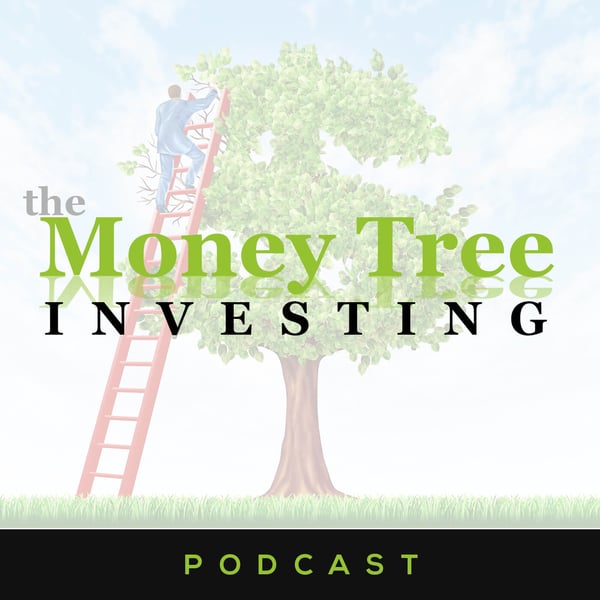The Inverted Yield Curve Distorting The Financial Markets And Your Portfolio
Money Tree Investing
Money Tree Investing Podcast
4.6 • 658 Ratings
🗓️ 11 September 2024
⏱️ 54 minutes
🧾️ Download transcript
Summary
Historically, every time the yield curve inverts, a recession follows, but don't fret just yet, this could be correlation, not causation. Recession tends to follow when the yield curve reverts back to normal after inversion, rather than during the inversion itself. The Federal Reserve's themselves and their actions have impacted the yield curve over the year and shifts in banking behavior can slow the economy. Changes in economic conditions and market behaviors suggest a potential recession is forthcoming, but don't panic yet, you can't predict the market.
Today we discuss...
- The inverted yield curve occurs when short-term interest rates exceed long-term rates, which is generally considered abnormal.
- The Fed's recent rate hikes caused the short end of the yield curve to increase sharply, resulting in an inversion.
- Banks are less likely to lend during periods of an inverted yield curve because lending at a lower rate than they borrow leads to losses.
- Changes in how money is created may alter the predictive power of the yield curve inversion as a recession indicator.
- Household allocation to stocks has recently hit an all-time high, indicating extreme market complacency.
- Fixed income, traditionally seen as a conservative investment, became the worst-performing asset class in 2022 due to interest rate volatility.
- Many investors may be unaware of their true risk tolerance, having not experienced significant capital loss since the 2008-2009 financial crisis.
- Risk in investing includes not just losing money but also the loss of time, as shown by the S&P 500's negative performance from 2000 to 2013.
- Confidence in the American Dream has significantly eroded since 2012, with fewer people believing hard work will lead to success.
- Credit card defaults are reaching record highs, surpassing previous peaks seen during the dot-com bubble and the financial crisis.
- U.S. government spending is projected to increase significantly, with 87% allocated to interest expenses, Social Security, and healthcare.
- Food prices have reached new highs, contributing to financial stress for consumers.
- The cost of U.S. federal debt interest has skyrocketed, reaching $1.1 trillion annually, or $3 billion per day.
- There is concern that the Federal Reserve is not truly independent, with its actions influenced by government, banks, and other powerful entities.
For more information, visit the show notes at https://moneytreepodcast.com/inverted-yield-curve-641
Today's Panelists:
Kirk Chisholm | Innovative Wealth
Douglas Heagren | ProCollege Planners
Follow on Facebook: https://www.facebook.com/moneytreepodcast
Follow LinkedIn: https://www.linkedin.com/showcase/money-tree-investing-podcast
Follow on Twitter/X: https://x.com/MTIPodcast
Transcript
Click on a timestamp to play from that location
| 0:00.0 | Welcome to the Money Tree Investing Podcast. |
| 0:04.0 | Stock market, wealth, personal finance, value stocks, invest in your life. |
| 0:10.0 | Hello, Smart MoneyTee podcast listeners. Welcome to this week's show. |
| 0:14.0 | My name's Kirk Chisholm and I'll be your host. So today I'm joined once again with my good friend Doug Heygren. |
| 0:19.0 | Hey Doug. |
| 0:20.0 | Happy Friday, Kirk. Good to see you again. |
| 0:22.4 | Happy Friday. I'm excited. My kids are back to school this week. I know everyone else's kids |
| 0:27.3 | went back before this week, but mine went back this week on Labor Day. This is still weird to me |
| 0:33.1 | that we had to go on Labor Day. But he's having a good time so far. And I'm happy that he's happy |
| 0:38.2 | and I think we're all going back to the new routine. So as we kind of dive right in on this |
| 0:43.2 | fresh fall Friday, lots of new stuff going on. I want to get into some of it. But one thing I wanted |
| 0:49.8 | to discuss before we get into the news, actually it's part of the news is I've been seeing a lot |
| 0:55.8 | again. This started a few years ago and we're seeing it again now is the inverted yield |
| 1:01.6 | curve. Now, a few years ago, I think it was 2022, the yield curve inverted. And when that |
| 1:09.4 | happened, I'm going to share this with y'all. |
| 1:13.4 | Y'all, I can't believe I said y'all. |
| 1:15.3 | So here is the yield curve, and this is the two and ten yield curve. |
| 1:20.3 | Basically what that means is they're taking the two-year treasury and the 10-year treasury, |
| 1:25.6 | and normally the 10-year treasury should be higher, should have a higher yield than the 10-year treasury. And normally, the 10-year treasury should be higher, should have a |
| 1:30.5 | higher yield than the two-year. Because typically, what will happen is the short of the time frame, |
| 1:36.6 | the lower the yield. The longer the time frame, the higher the yield. That is a normal yield curve. |
| 1:42.4 | Now, occasionally, the yield curve will invert. What that means is that the two-year |
... |
Please login to see the full transcript.
Disclaimer: The podcast and artwork embedded on this page are from Money Tree Investing Podcast, and are the property of its owner and not affiliated with or endorsed by Tapesearch.
Generated transcripts are the property of Money Tree Investing Podcast and are distributed freely under the Fair Use doctrine. Transcripts generated by Tapesearch are not guaranteed to be accurate.
Copyright © Tapesearch 2025.

